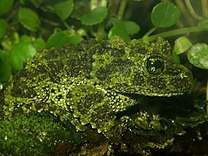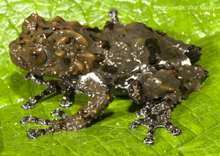Theloderma
Theloderma, the bug-eyed frogs, mossy frogs or warty frogs,[1] is a genus of frogs in the family Rhacophoridae, subfamily Rhacophorinae.[2] They are found from northeastern India and southern China, through Southeast Asia, to the Greater Sunda Islands; the highest species richness is in Indochina.[3] Some species, especially T. corticale, are sometimes kept in captivity.[1]
| Theloderma | |
|---|---|
.jpg) | |
| Theloderma albopunctatum | |
| Scientific classification | |
| Kingdom: | Animalia |
| Phylum: | Chordata |
| Class: | Amphibia |
| Order: | Anura |
| Family: | Rhacophoridae |
| Subfamily: | Rhacophorinae |
| Genus: | Theloderma Tschudi, 1838 |
| Type species | |
| Theloderma leporosa Tschudi, 1838 | |
| Diversity | |
| See text | |
They are medium to small-sized frogs with maximum snout–vent lengths that range from 2 to 7.5 cm (0.8 to 3.0 in) depending on species, and their skin can be smooth, warty or tuberculated.[3] The genus includes species that are contrastingly marked, but most are very well-camouflaged, resembling plant material (typically bark or moss) or bird droppings.[3][4]
Little is known about their behavior, but they feed on small arthropods. In species where known, breeding takes place in a small water pool in a cavity of a tree, bamboo or karst.[1][3][4] The female places 4–20 eggs just above the water. After about one to two weeks they hatch into tadpoles that drop into the water; they metamorphose into froglets after a few months to a year.[1][3]
Species and taxonomy
The sister taxon of Theloderma is Nyctixalus. The taxonomy of this genus and Nyctixalus as well as Theloderma moloch has been in flux;[2] today both AmphibiaWeb and Amphibian Species of the World recognize the two genera as valid.[2][5]
Following the Amphibian Species of the World, there are 26 recognized species in the genus Theloderma:[2]
- Theloderma albopunctatum (Liu and Hu, 1962)
- Theloderma annae Nguyen, Pham, Nguyen, Ngo, and Ziegler, 2016
- Theloderma asperum (Boulenger, 1886)
- Theloderma auratum Poyarkov, Kropachev, Gogoleva, and Orlov, 2018
- Theloderma baibengense (Jiang, Fei, and Huang, 2009)
- Theloderma bicolor (Bourret, 1937)
- Theloderma corticale (Boulenger, 1903)
- Theloderma gordoni Taylor, 1962
- Theloderma horridum (Boulenger, 1903)
- Theloderma lacustrinum Sivongxay, Davankham, Phimmachak, Phoumixay, and Stuart, 2016
- Theloderma laeve (Smith, 1924)
- Theloderma lateriticum Bain, Nguyen, and Doan, 2009
- Theloderma leporosum Tschudi, 1838
- Theloderma licin McLeod and Norhayati, 2007
- Theloderma moloch (Annandale, 1912)
- Theloderma nagalandense Orlov, Dutta, Ghate, and Kent, 2006
- Theloderma nebulosum Rowley, Le, Hoang, Dau, and Cao, 2011[6]
- Theloderma palliatum Rowley, Le, Hoang, Dau, and Cao, 2011[6]
- Theloderma petilum (Stuart and Heatwole, 2004)
- Theloderma phrynoderma (Ahl, 1927)
- Theloderma pyaukkya Dever, 2017
- Theloderma rhododiscus (Liu and Hu, 1962)
- Theloderma ryabovi Orlov, Dutta, Ghate, and Kent, 2006
- Theloderma stellatum Taylor, 1962
- Theloderma truongsonense (Orlov and Ho, 2005)
- Theloderma vietnamense Poyarkov, Orlov, Moiseeva, Pawangkhanant, Ruangsuwan, Vassilieva, Galoyan, Nguyen, and Gogoleva, 2015
References
- Lott, D. (2017). "Keeping and breeding mossy frogs". Practical Reptile Keeping. July 2017: 38–45.
- Frost, Darrel R. (2016). "Theloderma Tschudi, 1838". Amphibian Species of the World: an Online Reference. Version 6.0. American Museum of Natural History. Retrieved 8 January 2017.
- Poyarkov, Jr., N.A.; N.L. Orlov; A.V. Moiseeva; P. Pawangkhanant; T. Ruangsuwan; A.B. Vassilieva; E.A. Galoyan; T.T Nguyen; S.S. Gogolev (2015). "Sorting out moss frogs: mtDNA data on taxonomic diversity and phylogenetic relationships of the Indochinese species of the genus Theloderma (Anura, Rhacophoridae)". Russian Journal of Herpetology. 22 (4): 241–280.CS1 maint: multiple names: authors list (link)
- Sivongxay, N.; M. Davankham; S. Phimmachak; K. Phoumixay; B.L. Stuart (2016). "A new small-sized Theloderma (Anura: Rhacophoridae) from Laos". Zootaxa. 4147 (4): 433–442. doi:10.11646/zootaxa.4147.4.5.
- "Rhacophoridae". AmphibiaWeb: Information on amphibian biology and conservation. [web application]. Berkeley, California: AmphibiaWeb. 2016. Retrieved 8 January 2017.
- Jodi Rowley (2011-11-23). "Two new species of moss frog discovered". Australian Museum.

